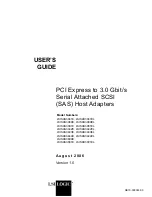
460 Configuring and monitoring FCIP extension services
IPSec implementation over FCIP
Internet Protocol security (IPsec) uses cryptographic security to ensure private, secure communications over
Internet Protocol networks. IPsec supports network-level data integrity, data confidentiality, data origin
authentication, and replay protection. It helps secure your SAN against network-based attacks from
untrusted computers, attacks that can result in the denial-of-service of applications, services, or the network,
data corruption, and data and user credential theft. By default, when creating an FCIP tunnel, IPsec is
disabled.
Used to provide greater security in tunneling on a B-Series Multi-Protocol Router Blade or an HP
StorageWorks 400 Multi-Protocol Router, the IPsec feature does not require you to configure separate
security for each application that uses TCP/IP. When configuring for IPsec, however, you must ensure that
there is a B-Series Multi-Protocol Router Blade or an HP StorageWorks 400 Multi-Protocol Router at each
end of the FCIP tunnel. IPsec works on FCIP tunnels with or without IP compression (IPComp), FCIP
Fastwrite, and Tape Pipelining. IPsec can be created only on tunnels using IPv4 addressing.
IPsec requires the High-Performance Extension over FCIP/FC license.
IPsec uses some terms that you should be familiar with before beginning your configuration. These are
standard terms, but are included here for your convenience.
3
15 / 001111
3 / 011
Medium QoS
4
19 / 010011
3 / 011
Medium QoS
5
23 / 010111
3 / 011
Medium QoS
6
27 / 011011
0 / 000
Class 3 Multicast
7
31 / 011111
0 / 000
Broadcast/Multicast
8
35 / 100011
0 / 000
Low Qos
9
39 / 100111
0 / 000
Low Qos
10
43 / 101011
4 / 100
High QoS
11
47 / 101111
4 / 100
High QoS
12
51 / 110011
4 / 100
High QoS
13
55 / 110111
4 / 100
High QoS
14
59 / 111011
4 / 100
High QoS
15
63 / 111111
0 / 000
-
Table 91
Default Mapping of DSCP priorities to L2Cos Priorities (continued)
Virtual
CIrcuit (VC)
DSCP priority/bits
L2CoS priority/bits
Assigned to:
Table 92
IPsec terminology
Term
Definition
AES
Advanced Encryption Standard. FIPS 197 endorses the Rijndael encryption algorithm as
the approved AES for use by US Government organizations and others to protect
sensitive information. It replaces DES as the encryption standard.
AES-XCBC
Cipher Block Chaining. A key-dependent one-way hash function (MAC) used with AES
in conjunction with the Cipher-Block-Chaining mode of operation, suitable for securing
messages of varying lengths, such as IP datagrams.
AH
Authentication Header - like ESP, AH provides data integrity, data source authentication,
and protection against replay attacks but does not provide confidentiality.
DES
Data Encryption Standard is the older encryption algorithm that uses a 56-bit key to
encrypt blocks of 64-bit plain text. Because of the relatively shorter key length, it is not a
secured algorithm and no longer approved for Federal use.
3DES
Triple DES is a more secure variant of DES. It uses three different 56-bit keys to encrypt
blocks of 64-bit plain text. The algorithm is FIPS-approved for use by Federal agencies.
Summary of Contents for A7533A - Brocade 4Gb SAN Switch Base
Page 1: ...HP StorageWorks Fabric OS 6 2 administrator guide Part number 5697 0016 Edition May 2009 ...
Page 24: ...24 ...
Page 99: ...Fabric OS 6 2 administrator guide 99 ...
Page 100: ...100 Managing user accounts ...
Page 118: ...116 Configuring standard security features ...
Page 164: ...162 Configuring advanced security features ...
Page 234: ...232 Installing and maintaining firmware ...
Page 268: ...266 Administering advanced zoning ...
Page 284: ...282 Configuring Enterprise class platforms ...
Page 292: ...290 Routing traffic ...
Page 294: ...292 Interoperability for merged SANs ...
Page 302: ...300 Configuring the Distributed Management Server ...
Page 334: ...332 iSCSI gateway service ...
Page 340: ...338 Administering NPIV ...
Page 407: ...Fabric OS 6 2 administrator guide 405 ...
Page 408: ...406 Using the FC FC routing service ...
Page 438: ...434 Administering extended fabrics ...
Page 460: ...456 Administering ISL trunking ...
Page 516: ...512 FICON fabrics ...
Page 526: ...522 Configuring and monitoring FICON Extension Services ...
Page 540: ...536 Configuring the PID format ...
Page 544: ...540 Understanding legacy password behavior ...
Page 546: ...542 Mixed fabric configurations for non merge SANs ...
Page 550: ...546 Migrating from an MP Router to a 400 MP Router ...
Page 558: ...554 Inband Management ...
Page 572: ...568 ...
















































